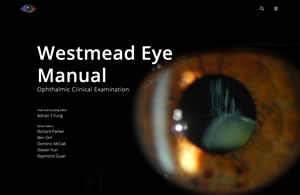27.1 Open Globe Injuries
Open globe injuries (OGI) require urgent management and repair to prevent significant ocular morbidity.[1,2] Vision loss from an OGI can be immediate or may develop months following the injury. Factors affecting visual prognosis include vision at presentation, mechanism, location/extent of injury, presence of relative afferent pupillary defect (RAPD), presence of retinal detachment and IOFB.[3,4,5,6] With the advent of enhanced microsurgical techniques and instrumentation along with improved understanding of ocular trauma, the prognosis of OGI have significantly improved over the years.[6]
Grob SaK, Carolyn. Management of Open Globe Injuries: Springer Link; 2018.
Agrawal R, Shah M, Mireskandari K, Yong GK. Controversies in ocular trauma classification and management: review. Int Ophthalmol. 2013;33:435-45
Cruvinel Isaac DL, Ghanem VC, Nascimento MA, Torigoe M, Kara-Jose N. Prognostic factors in open globe injuries. Ophthalmologica. 2003;217:431-5
Rofail M, Lee GA, O'Rourke P. Prognostic indicators for open globe injury. Clin Exp Ophthalmol. 2006;34:783-6
Guven S, Durukan AH, Erdurman C, Kucukevcilioglu M. Prognostic factors for open-globe injuries: variables for poor visual outcome. Eye. 2019;33:392-7
Pieramici DJ, MacCumber MW, Humayun MU, Marsh MJ, de Juan E, Jr. Open-globe injury. Update on types of injuries and visual results. Ophthalmol 1996;103:1798-803
Pieramici DJ, MacCumber MW, Humayun MU, Marsh MJ, de Juan E, Jr. Open-globe injury. Update on types of injuries and visual results. Ophthalmol 1996;103:1798-803
Critical points in the assessment/management of OGI include:
- Detailed history of the injury including timing, mechanism and likelihood of an IOFB
- Documentation of workplace injuries and eye-protection, as this may have important medicolegal implications
- Patient’s tetanus immunization status, may require update if not within recommended standards[1,2]
- Detailed ophthalmic examination of both eyes including best corrected visual acuity, assessment for a RAPD, identification and extent of laceration. Associated injuries may include: Lens violation, phacodonesis, lens expulsion, iridiodialysis, hyphema, vitreous hemorrhage (VH), suprachoroidal hemorrhage, retinal detachment (RD), and optic nerve avulsion[5,6]
Guven S, Durukan AH, Erdurman C, Kucukevcilioglu M. Prognostic factors for open-globe injuries: variables for poor visual outcome. Eye. 2019;33:392-7
Pieramici DJ, MacCumber MW, Humayun MU, Marsh MJ, de Juan E, Jr. Open-globe injury. Update on types of injuries and visual results. Ophthalmol 1996;103:1798-803
Note
Once an OGI has been confirmed, limit excessive manipulation to prevent further injury. If required, further examination should be deferred until in the operating room and under general anesthesia
- Radiologic studies with non-contrast fine-cut orbital CT scan should be obtained in all OGI prior to surgery, to evaluate for possible IOFBs and other injuries. Gentle B-scan ultrasonography may be utilized if high concern for IOFB. Magnetic resonance imaging (MRI) is contraindicated in settings of potential IOFB[7,8,9]
- Informed consent (including the possibility for loss of the eye or sympathetic ophthalmia) should be obtained prior to surgery
- The injured eye should be shielded (not patched) to avoid further injury prior to surgery
- Systemic (e.g. intravenous) analgesia, anti-emetics and antibiotics are often indicated
- Urgent repair is strongly recommended, however a delay up to 36 hours in select scenarios may not significantly affect outcomes. Be cognizant of the possibility of endophthalmitis, however[1,2,10]
Rong AJ, Fan KC, Golshani B, Bobinski M, McGahan JP, Eliott D, et al. Multimodal imaging features of intraocular foreign bodies. Semin Ophthalmol. 2019;34:518-32
Gor DM, Kirsch CF, Leen J, Turbin R, Von Hagen S. Radiologic differentiation of intraocular glass: evaluation of imaging techniques, glass types, size, and effect of intraocular hemorrhage. American Journal of Roentgenology. 2001;177:1199-203
Deramo VA, Shah GK, Baumal CR, Fineman MS, Corrêa ZM, Benson WE, et al. Ultrasound biomicroscopy as a tool for detecting and localizing occult foreign bodies after ocular trauma. Ophthalmol 1999;106:301-5
Grob SaK, Carolyn. Management of Open Globe Injuries: Springer Link; 2018.
Agrawal R, Shah M, Mireskandari K, Yong GK. Controversies in ocular trauma classification and management: review. Int Ophthalmol. 2013;33:435-45
Lieb DF, Scott IU, Flynn HW, Jr., Miller D, Feuer WJ. Open globe injuries with positive intraocular cultures: factors influencing final visual acuity outcomes. Ophthalmol 2003;110:1560-6
Note
The goals of surgery are to:
- Meticulous wound identification and closure
- Remove any intraocular foreign body
- Repair associated injuries. The presence of secondary injuries such as traumatic cataract or retinal detachment can be managed as a second procedure once globe integrity has been achieved and intraocular hemorrhage/inflammation has settled
General Anesthesia (GA) has been historically used for OGI and remains a popular modality. Of note, regional anesthesia with Monitored Anesthesia Care can be used in select, less complicated cases.[11,12]
All rights reserved. No part of this publication which includes all images and diagrams may be reproduced, distributed, or transmitted in any form or by any means, including photocopying, recording, or other electronic or mechanical methods, without the prior written permission of the authors, except in the case of brief quotations embodied in critical reviews and certain other noncommercial uses permitted by copyright law.
Westmead Eye Manual
This invaluable open-source textbook for eye care professionals summarises the steps ophthalmologists need to perform when examining a patient.

